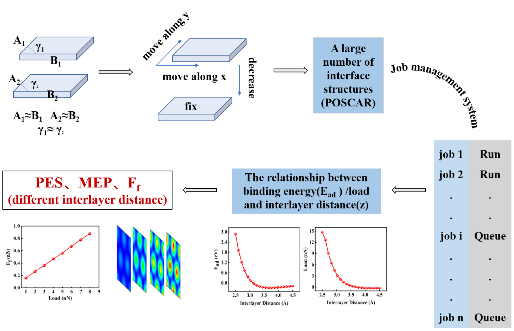Study the interfacial friction properties of two-dimensional materials via high-throughput calculations
Zhiguo Chen1, Xiaopeng Ruan1, Zichun Cui1, Xiaoli Fan1*, Feng Zhou1,2*
1Center of Advanced Lubrication and Seal Materials, Northwestern Polytechnical University, 127 YouYi Western Road, Xi’an, Shaanxi 710072, China
2 State Key Laboratory of Solid Lubrication, Lanzhou Institute of Chemical Physics, Chinese Academy of Sciences, Lanzhou 730000, China
EXTENDED ABSTRACT: Friction generally occurs at contacting interfaces with relative motion or tendency to relative motion, impeding the relative motion and generating energy consummation. By adopting the atomic-scale high-throughput computational methods and high-throughput experimental techniques, we are going to construct a database of lubricating material’s composition-structure-physical parameters-lubricating properties, to study the intrinsic correlation between composition-structure-physical parameters-lubricating properties of lubrication materials, and then investigate tribological properties and related surface-interface interactions and phenomena from the atomic scale. It is a revolutionary and advanced way to improve the efficiency of lubricating material development and to discovery and design new lubricating materials, it is also the frontier field of nanotribology. We have developed an automated two-dimensional (2D) material interface tribological properties calculation software, HJC2S (homogenous/heterogenous junction construction and frictional properties calculation software). The function of HJC2S includes 2D material interface modeling, potential energy surface calculation and plotting, minimum energy path search for the interface sliding, applied load and friction as well as friction coefficient solving, etc. It achieved automated batch modeling, batch task submission, multi-task concurrent parallel calculation as well as automated data processing and image plotting. The flow chart of the software is shown in Figure 1. Adopting this software, we calculated the potential energy surface of bilayer graphene and bilayer BN under different loads, verified the reliability and efficiency of the method and software. Furthermore, we investigated the potential energy surface of the functionalized BN surface and the tribological properties under different loads, then suggested a structural modulating way to enhance the tribological properties of BN interface. In addition, interlayer nano-tribological properties of bilayer graphdiyne (GDY) was studied via molecular dynamics simulations, the potential energy surface and electronic structure of interface were investigated via the first-principles calculations to explore the intrinsic mechanism. We found the robust superlubricating state achieved on the interface of relatively rotated bilayer GDY, such an interface with ultralow friction is formed at nearly arbitrary rotation angles and sustained at temperatures up to 300 K (relatively rotation angles from 1° to 59°, loads less than 1.0 nN/atom, sliding speeds less than 0.50 Å/ps, and temperatures below 300 K). We also identified a reverse correlation between the friction coefficient and the size of the Moiré pattern formed on the surface of the incommensurate stacked GDY bilayers, particularly in the small size region. Our investigations show that the ultralow friction and the reduction of the friction coefficient with the increase in size of Moiré lattice are closely related to the interfacial energetics and charge density as well as the atomic arrangement. Our findings enable the development of a new solid lubricant with novel superlubricating properties. Combined with our high-throughput calculation software and high-throughput experimental technology and database technology, the rapid prediction of tribological properties and rapid screening and designing of lubricating materials will be achieved.

Figure 1. The flow chart of the 2D material interface tribological properties calculation software

Xiaoli Fan, member of the 12th CPPCC Shaanxi Provincial Committee, Professor at School of Materials Science and Engineering, Northwestern Polytechnical University (NPU), and Vice Dean of Queen Mary University of London Engineering School, NPU; Distinguished Young Scholars of Natural Science Foundation in Shaanxi Province, New Century Excellent Talents in Chinese University, Aoxiang Young Scholar of Northwestern Polytechnical University. She is a member of the General Rules Committee and the Computational Technology Committee in the field of materials genetics of the China Materials and Testing Standards Platform, and a member and deputy secretary general of Computational Materials Science Branch of Chinese Materials Research Society. She is also in charge of research projects of the National Natural Science Foundation of China, sub-projects of the Key R&D Program of the Ministry of Science and Technology, key projects of the Natural Science Foundation of Shaanxi Province, and funds of the Ministry of Education. Her research outputs have been published on Nano letters, Adv. Mater., J. Phys. Chem. Lett, J. Mater. Chem. A, Phy. Rev. Lett, J. Am. Chem. Soc., Green Chem., ACS Appl. Mater. & Inter, Acta. Mater., Phys. Rev. B, J. Phys. Chem. C, Phys. Chem. Chem. Phys, etc.